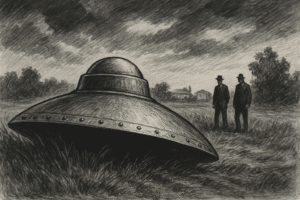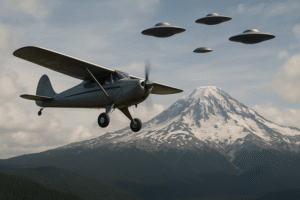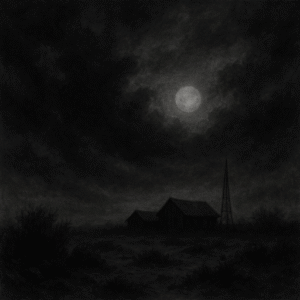Executive summary (so you know what follows)
-
Core claim: On 13 June 1933, an unconventional craft allegedly crashed/landed in northern Italy, widely tagged to Magenta (Lombardy) or the Vergiate area near Lake Maggiore. Benito Mussolini purportedly ordered a blackout, and a secret cabinet—RS/33—was formed under Guglielmo Marconi to study the wreckage. The wreckage was allegedly stored at SIAI-Marchetti hangars in Vergiate; some later claims say the United States obtained it after WWII (The Black Vault).
-
Where this comes from: Starting in 2000, Italian ufologists Roberto Pinotti and Alfredo Lissoni publicised a cache of documents they said originated from Fascist-era files (“Fascist UFO Files”). Newspapers in Italy covered it at the time; the story re-entered English-language media after 2023 U.S. UAP whistleblower coverage (Popular Mechanics).
-
Status: Unproven. No publicly verifiable archival originals have been accepted by mainstream historians. Italian skeptics and analysts have raised multiple red flags about provenance and specifics (CISU).
1) How the story emerged: the initial report, who made it, and who was involved
1.1 The 2000 “Fascist UFO Files”
The modern story begins not in the 1930s but in 2000, when Roberto Pinotti (then of the Centro Ufologico Nazionale, CUN) and collaborator Alfredo Lissoni published and lectured about a set of Fascist-period documents they said had surfaced anonymously. These materials described:
-
a June 13, 1933 crash/forced landing of an unusual craft in northern Italy (near Milan/Lombardy—variously labelled Magenta or “near Lake Maggiore”);
-
a press censorship order attributed to Mussolini to “tacitare i testimoni” (silence witnesses);
-
the creation of Gabinetto RS/33 (“Ricerche Speciali”) to study the object, nominally under Guglielmo Marconi (La Repubblica).
Italian press picked it up at the time. La Repubblica (11 Apr 2000) and Quotidiano Nazionale (18 Apr 2000) ran pieces summarising the CUN claims: an unknown aircraft down in 1933, regime censorship, and a secret study unit. The basic framing—1933 date, RS/33, Vergiate storage—has persisted in later retellings.
1.2 The names you’ll keep seeing
-
Benito Mussolini – Prime Minister/Dictator; allegedly authorised censorship and formation of RS/33 after the incident.
-
Guglielmo Marconi – Nobel-winning radio pioneer; alleged figurehead/chair of RS/33.
-
Italo Balbo – Air Minister.
-
Galeazzo Ciano – Foreign Minister (and Mussolini’s son-in-law).
-
Arturo Bocchini – Head of OVRA, the regime’s secret police.
-
SIAI-Marchetti (Savoia-Marchetti) – aircraft manufacturer; alleged storage site in Vergiate.
1.3 How the story re-ignited after 2023
In mid-2023, U.S. media reported on UAP whistleblower testimony that referenced an Italian 1933 crash (NewsNation). Mainstream outlets summarised the Italian claims and the backlash from skeptics. Italian press revisited it in 2017 (La Stampa) and again in 2024 (Corriere UFO Blog); several pieces repeat the same spine: June 13, 1933; Vergiate/Magenta; RS/33; storage at SIAI-Marchetti; possible postwar U.S. transfer.
2) What supposedly happened on 13 June 1933: location, witnesses, immediate response
2.1 Date and place
The core date nearly all retellings give is 13 June 1933. Location labels vary between Magenta (a town west of Milan) and the broader Vergiate / Lake Maggiore area in Varese province.
2.2 What the alleged documents say about the first hours
-
A strange craft reportedly came down (some narratives say “crashed,” others say “forced landing”).
-
Press censorship followed almost immediately—telegrams/notes ordering editors to bury the story, allegedly signed off within Mussolini’s chain of command.
-
The wreckage (and, in some versions, two deceased occupants) was secured by regime forces and moved under guard (Il Fatto Quotidiano).
The “bodies” component is mostly present in later, more sensational retellings. It’s not a consensus element even within ufology, and it’s absent from some earlier write-ups that focus strictly on a craft and a technical study unit.
3) Craft descriptions: size, shape, features
Descriptions vary because we’re dealing with second- or third-hand summaries of alleged 1930s documents. The recurring descriptors across Italian press and subsequent round-ups:
-
Shape: usually bell-like or acorn-like, sometimes generically “discoid” (Corriere).
-
Size: often quoted as roughly 10–12 meters.
-
Finish: “unconventional aircraft,” no conventional prop surfaces are mentioned.
-
Propulsion: unspecified.
One oft-repeated detail is a sketch reproduced by ufology outlets, said to derive from the alleged RS/33 papers. It shows a rounded, non-planform object—more bell/acorn than classic saucer (The Black Vault).
4) Where the wreckage went: from the field to Vergiate
The best-known logistical claim is that the craft (or its remains) was transported to the SIAI-Marchetti (Savoia-Marchetti) facilities in Vergiate, near Lake Maggiore—an area thick with aviation infrastructure then and now. Italian articles citing CUN research in 2000 explicitly say “hangars in Vergiate.” Later pieces repeat that location, sometimes adding that the object sat there for years under protection (The Black Vault).
5) RS/33: What the alleged research cabinet was, and who sat on it
The story consistently frames Gabinetto RS/33 (“Ricerche Speciali”) as a cross-disciplinary committee chartered by Mussolini after the 1933 incident, put nominally under Guglielmo Marconi. Names repeated across compilations include:
-
Guglielmo Marconi (chair/sponsor);
-
scientists/engineers like Gaetano Arturo Crocco, Giancarlo Vallauri, Francesco Giordani, Filippo Bottazzi, Francesco Severi, Romualdo Pirotta;
-
political protection from Balbo and Ciano;
-
OVRA (Bocchini) for secrecy (Padua University thesis).
6) A competing explanation lurking in the background: secret aeronautics
There’s a parallel thread: by the late 1940s/1950, Italian engineer Giuseppe Belluzzo publicly claimed Italy and Germany developed disc-like aircraft concepts in the early 1940s. Italian and German press of 1950 ran with “dischi volanti” as human technology, not aliens (Wikipedia summary).
Some skeptics argue that if an unusual object landed in 1933, it could have been a prototype or misidentified aircraft and that RS/33 (if it existed) could have been a technical failure review rather than an alien-tech panel.
7) “What happened after 1933?”: alleged postwar transfer to the U.S.
You’ll see claims that after WWII the wreckage (and/or documents) were acquired by U.S. authorities—sometimes with Vatican awareness or assistance. Italian features from 2017 and 2024 repeat this as a storyline, tying it to modern whistleblower chatter in the U.S. Again: it’s asserted, not proven (Il Fatto Quotidiano).
8) Where the story falls apart: provenance problems and skeptical reviews
-
Document provenance: The alleged Fascist-era documents surfaced in copies, not in a publicly verifiable Fascist archive box with chain-of-custody. Italian skeptics (CISU) have been blunt that the files have not met basic authenticity checks (CISU).
-
Shifting geography: “Magenta” vs “Vergiate/Lake Maggiore” swapping across versions suggests legend-creep.
-
Bodies/no bodies: Sensational details like two tall, pale “pilots” appear in later articles/blogs.
-
Lack of primary confirmations: No Marconi diary entry, Balbo directive, Ciano note, OVRA log, or SIAI-Marchetti inventory entry has been produced in a way that would satisfy professional historians.
9) Chronology (what the literature actually says)
-
13 June 1933 – Alleged crash/forced landing of a non-conventional craft in Lombardy (labelled Magenta in many summaries; also framed as near Vergiate/Lake Maggiore).
-
1933–late 1930s – Object allegedly held at SIAI-Marchetti hangars, Vergiate; RS/33 operates under Marconi.
-
Post-1945 – Claimed transfer of materials/documents to the U.S..
-
2000 – Pinotti & Lissoni publicise the “Fascist UFO Files”; Italian press (e.g., La Repubblica and QN) cover the story.
-
2017–2024 – Italian media revisit the case; 2023 U.S. whistleblower coverage pushes it into English-language outlets.
10) The Magenta label—why that town?
Two reasons:
-
Geography & shorthand. Magenta is a known toponym west of Milan; tagging the case to a recognizable town helped the story spread.
-
Vergiate vs Magenta confusion. The storage claim is solidly tied to Vergiate’s SIAI-Marchetti; if the crash site was somewhere else in Lombardy, “Magenta” may simply be a sticky media label.
11) What would count as proof?
-
Archival originals (not photocopies) from 1933 with verifiable provenance.
-
Independent documentary trails (insurance claims, police reports, spiked newspapers) from June 1933.
-
Corroborating third-country intercepts (e.g., French/British attaché reports).
So far, none of that has been produced.
12) How this fits in the broader UFO history timeline
If true, 1933 Italy would predate Roswell (1947) by fourteen years and sit closer to early “mystery aircraft” and airship panics than to the post-war “flying saucer” wave. That’s why the story matters: it would push crash-retrieval programs back into interwar Europe, not Cold War America.
13) A note on Belluzzo and “Nazi UFOs”: why it’s relevant background
In March 1950, former Italian minister and turbine engineer Giuseppe Belluzzo told Il Giornale d’Italia that Italy and Germany worked on disc-type aircraft in the early 1940s. German names like Schriever/Habermohl pop up in those reports. Italy’s Air Force later dismissed such claims. Relevance here: the idea of disc-like craft in European programs existed in public discourse by 1950, which might colour how post-2000 readers interpret a 1933 label like “disco volante.”
14) So—what can we say firmly, and what stays in the grey?
Firm (about the claim’s history, not its truth):
-
The Magenta/Vergiate 1933 story has a consistent core: date (13 June 1933), regime censorship, RS/33 under Marconi, SIAI-Marchetti/ Vergiate storage.
-
The story debuted publicly via CUN researchers Pinotti and Lissoni in 2000 and has been recycled since.
Grey (where evidence is thin/contested):
-
Exact crash site (Magenta vs precise coordinates).
-
Bodies (some late sources add two corpses; not uniformly present).
-
Archival proof of RS/33.
-
Post-war U.S. transfer.
15) Primary claims and key sources (for your own digging)
-
Pinotti & Lissoni: Mussolini e gli UFO (Idea Libri, 2001) — foundation of the modern narrative.
-
Italian media recountings:
-
La Stampa (2017) summarising the 1933 crash near Lake Maggiore and Vergiate storage.
-
Il Fatto Quotidiano (2017) on the post-war U.S. hand-off claim.
-
Corriere UFO blog (2024) restating size/shape and Marconi/RS-33 framing.
-
-
The Black Vault casefile: English-language overview compiling the standard points.
-
Skeptical reviews: CISU critique and Metabunk’s technical alternatives.
16) Assessment
If your bar is journalistic mapping of a claim’s who/what/when/where, we can deliver that: 13 June 1933, Lombardy (Magenta/Vergiate), alleged RS/33 under Marconi, SIAI-Marchetti hangars, with Mussolini ordering secrecy.
If your bar is historical proof, we’re not there. The story stands or falls on documents whose originals and provenance have not been publicly authenticated. Without that, “Magenta 1933” remains a compelling but unproven pre-Roswell crash-retrieval narrative.



